On Saturday, January the 16th a group of daring hikers braved the weather to hike the trails of Little Buffalo State Park. It was a cold, damp, drizzly morning to start and we did get rained on for a short period of time. We were fortunate that the sun did stick its head out a few times before the wind hit. With all the climbing we did the weather didn’t phase us.
A total of 5.5 miles was traversed over trails where we counted 10 climbs. We started at Middle Ridge Trail to Buffalo Creek Trail and connected with the Buffalo Ridge Trail, finally ending up at the covered bridge, then walked back to the office parking lot for the completion of the hike.
- Doe, Female, White Tailed Deer
- Typical deer track with dew claws not evident,
- Deer trails in winter are called yards.
The theme for the event was, “The White Tailed Deer”. The white tailed deer, belonging to the Cervidae family, are referred to as Cervids meaning hooved. Most people are familiar with deer tracks which exemplify a cloven or split hoof. When deer walk through deep mud or heavier deer leave prints you can see the dew claw impressions. There are two dew claws above the back side of each hoof.
- Buck eating branch ends.
- Deer eat bark in the winter.
White tailed deer are also classified ruminants meaning multiple stomachs and cud chewing animals. Deer have four stomachs. They are active at dusk and dawn making them crepuscular mammals. During this time they come out of cover, quickly eat, return to cover, regurgitate their food from the first stomach, and chew it (chewing their cud). This behavior limits the amount of time the deer are out in the open exposed to predators. Deer eating habits change depending upon what is available each season. They are vegetarians eating herbaceous and woody plants. In Spring and Summer they will feed on green plants. Hard and soft mast are their preferred food source during the fall. This includes nuts, buds, seeds,and fruit. In winter food sources are scarce when they select bark, tree branches (ends), vines, and bushes. Deer will gravitate toward food sources providing the most nutrients, one of the reasons why they prefer acorns in the fall and hemlock during the winter months. These items are high in nutritional value.
No matter the season, do not feed the deer! You may think you are helping them survive when you are really increasing their chances of death and disease. Feeding the deer disrupts the micro-organisms in their digestive track which can often lead to death. In winter deer will migrate long distances to reach feeding stations causing them to use up their fat reserves. Feeding deer results in the congregation of large groups of deer exposing them to the diseases such as: CWD, Chronic Wasting Disease, and EHD, Epizootic Hemmorrhagic Disease.
- Summer Coat
- Winter Coat
A deer’s coat also changes with the seasons. The summer coat is a reddish brown with short hairs and no underfur. In winter the coat becomes grayish brown with long hollow hairs and a thick, wooly underfur, The hollow hairs and underfur provide excellent insulation against the cold winter months, while the grayish brown coat provides camouflage against the gray color of bare trees and bushes. Air trapped between the hairs of both summer and winter coats make deer good floaters and swimmers.
Deer’s senses help them survive. The sense of sight is their keenest sense which is especially good at detecting motion. While detecting movement is not a problem, deer find it more difficult to see still objects. Their vision is keen in the light of day and the darkness of night. Scientist do not concur on what colors deer can see. Some scientists believe they see in blacks and grays while others feel they see some colors. Deer’s ears move independently allowing them to hear surrounding sounds warning of danger. Their sense of smell is also good for indicating danger, scents of communication from other deer, and the presence of other animals,
- Deer Skull With Antlers
- Buck With Ten Point Antlers
- Buck Rub
Much can be determined about deer when studying a deer skull. By observing the eye sockets one can surmise that deer play the role of “prey”, because the eye sockets are located on the sides of the head. This gives the deer a wide range of vision protecting it from predators. If you look at the top of the mouth area you may be surprised to see there are no incisors. One clear sign that a deer has been browsing are shredded branch ends of trees and bushes since deer do not have the teeth to make a clean cut like a rabbit.
The deer’s antlers will also help one learn more about it. (Antlers are made of bone and are shed yearly, while horns are made of carotene and are not shed.) Antlers begin to grow in March and April. The length of the day triggers hormone production that in turn causes the antlers to grow. Growing antlers are covered with a blood rich skin called velvet, which is shed in the fall. In October one can find smaller buck rubs where the male deer scrapes off the itchy velvet by rubbing the antlers up and down small trees (1 to 6″ in diameter). The buck, or male deer, will eat the velvet since it is high in protein. Buck rubs found in November are for purposes of marking territory and attracting mates. These rubs will be larger. As bucks age they often have larger antlers than the year before, if they are getting proper nourishment and are healthy. Poor nourishment and disease can result in very small antlers called spikes. Antlers are shed in late winter. Scientist believe that birthdate determines when antlers are shed. It is difficult to find antlers that have been shed in the woods, since they are high in calcium and nutrients and are quickly consumed by other animals, especially rodents.
In late May the does, female deer, give birth to one to three fawns. The number of fawns is determined by age and health of the mother. Fawns are born with spotted coats that make them look like the sun shining on the forest floor and helps keep them hidden. A fawn has little to no scent and will remain motionless as its defense against dangers (one of the reasons why many fawns are run over by farm equipment as they lay in fields). The mother comes for feedings and leaves quickly to avoid drawing predators to her young through her scent.
- Two Deer Flailing
- Buck scraping the ground and scenting the area.
- White tail means danger!
Deer communicate with one another through sounds, scents, and behavior https://targetcrazy.com/hunting/deer-sounds-meanings/
Does whine for their fawns and the fawns answer with a bleat. Deer have many scent glands which can be located between the hooves, inside and outside of the legs, around the eyes and during the rut (mating season) the bucks develop glands on their heads. When rutting, bucks scrape the ground bare and scent mark it (called scrapes). Bucks usually scrape under trees with low hanging branches, marking them with the glands on their heads. Urine is also used to mark a scent. Scents are used for marking territory, recognition, sensing danger, and finding mates. Body language helps the deer interact with one another. A flicking tail means the deer is comfortable and there is no sign of danger. A tail held horizontally means something may be up. A tail pointing straight up flashing white is usually what you see as the deer run off warning of danger. When two deer meet and are not comfortable with one another the first move is a flattening of the ears with a stare followed by side stepping. if the confrontation continues the deer will raise up on hind legs and batter one another with their front legs (called flailing). Charging and butting heads is the last resort, but it often does not get that far due to one or the other backing down.
Deer herds are matriarchal with the most common group consisting of an adult doe, her fawns and her yearling female offspring. Some herds may consist of many generations of related does. The adult doe leaves the group during the summer to give birth, at which time the yearlings often disperse in sibling groups. Yearling bucks leave this sibling group in the fall when mating season approaches, and the yearling bucks and adult bucks remain alone. During winter months with heavy snows and in good feed areas you may see larger herds. Under these circumstances the deer will group together under cover and utilize the same trails in the snow (called yards) to conserve energy.
- Deer Scats (poop)
- Deer Trail
- Browse Line
Deer leave many signs of their presence. Rubs, scrapes, tracks, yards, shredded branch ends, and shredded tree bark have already been mentioned. Scat, trails, impressions and browse lines also indicate that deer are around. Scat is a fancy word for poop. It will vary in appearance depending upon what was consumed, as with most mammals. Trails are worn paths, many of which have been used for years causing depressions in the soil. When deer lay on grasses and in the snow they leave impressions. Browse lines are evident when there are no leaves on the lower branches of trees up to a certain point where the deer cannot reach. A browse line is usually indicative of too many deer in one area.
Now that you know most aspects involving the White Tail. Take some time to go out in the woods and fields, sit quietly and enjoy the beauty of this magnificent creature.


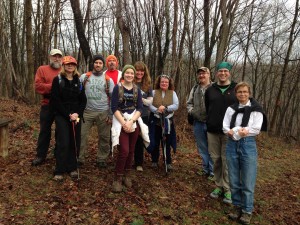
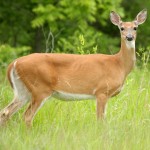
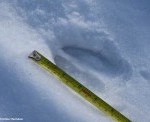
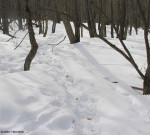
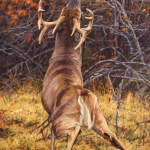
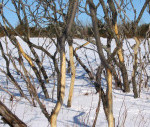
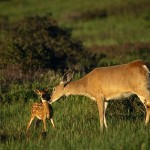

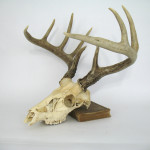
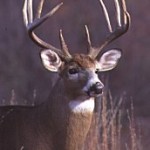
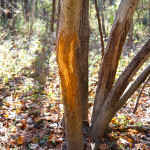

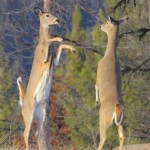
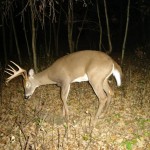
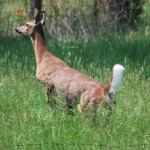
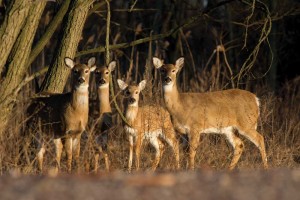
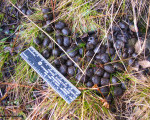
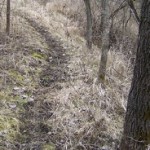
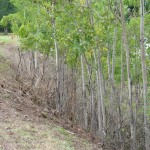
Great write up on the white tail deer ! I enjoyed the hike as well. Thanks for putting it all together.